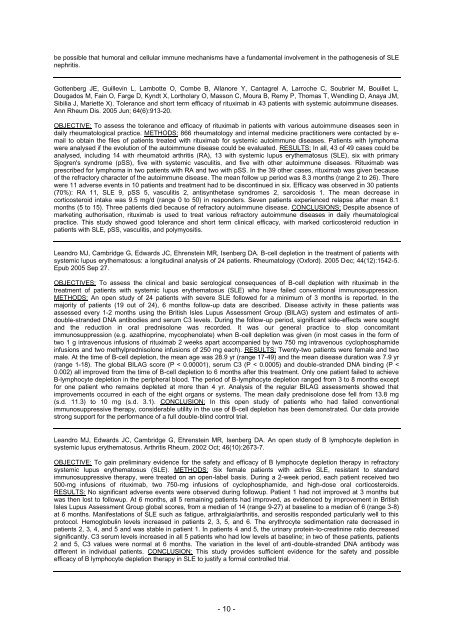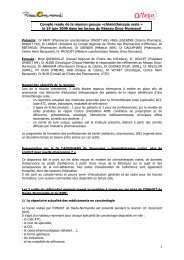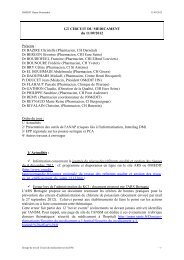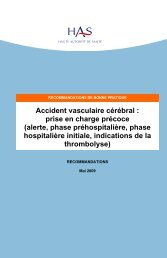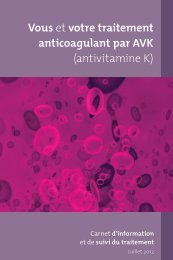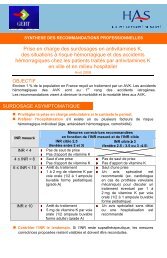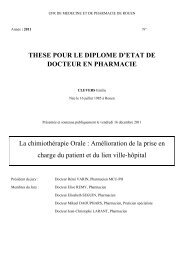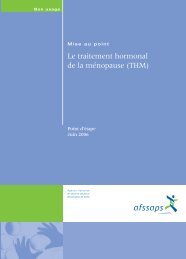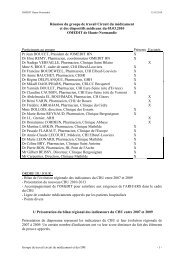RBU du Rituximab - OMéDIT de Haute-Normandie
RBU du Rituximab - OMéDIT de Haute-Normandie
RBU du Rituximab - OMéDIT de Haute-Normandie
Create successful ePaper yourself
Turn your PDF publications into a flip-book with our unique Google optimized e-Paper software.
e possible that humoral and cellular immune mechanisms have a fundamental involvement in the pathogenesis of SLE<br />
nephritis.<br />
Gottenberg JE, Guillevin L, Lambotte O, Combe B, Allanore Y, Cantagrel A, Larroche C, Soubrier M, Bouillet L,<br />
Dougados M, Fain O, Farge D, Kyndt X, Lortholary O, Masson C, Moura B, Remy P, Thomas T, Wendling D, Anaya JM,<br />
Sibilia J, Mariette X). Tolerance and short term efficacy of rituximab in 43 patients with systemic autoimmune diseases.<br />
Ann Rheum Dis. 2005 Jun; 64(6):913-20.<br />
OBJECTIVE: To assess the tolerance and efficacy of rituximab in patients with various autoimmune diseases seen in<br />
daily rheumatological practice. METHODS: 866 rheumatology and internal medicine practitioners were contacted by email<br />
to obtain the files of patients treated with rituximab for systemic autoimmune diseases. Patients with lymphoma<br />
were analysed if the evolution of the autoimmune disease could be evaluated. RESULTS: In all, 43 of 49 cases could be<br />
analysed, including 14 with rheumatoid arthritis (RA), 13 with systemic lupus erythematosus (SLE), six with primary<br />
Sjogren's syndrome (pSS), five with systemic vasculitis, and five with other autoimmune diseases. <strong>Rituximab</strong> was<br />
prescribed for lymphoma in two patients with RA and two with pSS. In the 39 other cases, rituximab was given because<br />
of the refractory character of the autoimmune disease. The mean follow up period was 8.3 months (range 2 to 26). There<br />
were 11 adverse events in 10 patients and treatment had to be discontinued in six. Efficacy was observed in 30 patients<br />
(70%): RA 11, SLE 9, pSS 5, vasculitis 2, antisynthetase syndromes 2, sarcoidosis 1. The mean <strong>de</strong>crease in<br />
corticosteroid intake was 9.5 mg/d (range 0 to 50) in respon<strong>de</strong>rs. Seven patients experienced relapse after mean 8.1<br />
months (5 to 15). Three patients died because of refractory autoimmune disease. CONCLUSIONS: Despite absence of<br />
marketing authorisation, rituximab is used to treat various refractory autoimmune diseases in daily rheumatological<br />
practice. This study showed good tolerance and short term clinical efficacy, with marked corticosteroid re<strong>du</strong>ction in<br />
patients with SLE, pSS, vasculitis, and polymyositis.<br />
Leandro MJ, Cambridge G, Edwards JC, Ehrenstein MR, Isenberg DA. B-cell <strong>de</strong>pletion in the treatment of patients with<br />
systemic lupus erythematosus: a longitudinal analysis of 24 patients. Rheumatology (Oxford). 2005 Dec; 44(12):1542-5.<br />
Epub 2005 Sep 27.<br />
OBJECTIVES: To assess the clinical and basic serological consequences of B-cell <strong>de</strong>pletion with rituximab in the<br />
treatment of patients with systemic lupus erythematosus (SLE) who have failed conventional immunosuppression.<br />
METHODS: An open study of 24 patients with severe SLE followed for a minimum of 3 months is reported. In the<br />
majority of patients (19 out of 24), 6 months follow-up data are <strong>de</strong>scribed. Disease activity in these patients was<br />
assessed every 1-2 months using the British Isles Lupus Assessment Group (BILAG) system and estimates of antidouble-stran<strong>de</strong>d<br />
DNA antibodies and serum C3 levels. During the follow-up period, significant si<strong>de</strong>-effects were sought<br />
and the re<strong>du</strong>ction in oral prednisolone was recor<strong>de</strong>d. It was our general practice to stop concomitant<br />
immunosuppression (e.g. azathioprine, mycophenolate) when B-cell <strong>de</strong>pletion was given (in most cases in the form of<br />
two 1 g intravenous infusions of rituximab 2 weeks apart accompanied by two 750 mg intravenous cyclophosphami<strong>de</strong><br />
infusions and two methylprednisolone infusions of 250 mg each). RESULTS: Twenty-two patients were female and two<br />
male. At the time of B-cell <strong>de</strong>pletion, the mean age was 28.9 yr (range 17-49) and the mean disease <strong>du</strong>ration was 7.9 yr<br />
(range 1-18). The global BILAG score (P < 0.00001), serum C3 (P < 0.0005) and double-stran<strong>de</strong>d DNA binding (P <<br />
0.002) all improved from the time of B-cell <strong>de</strong>pletion to 6 months after this treatment. Only one patient failed to achieve<br />
B-lymphocyte <strong>de</strong>pletion in the peripheral blood. The period of B-lymphocyte <strong>de</strong>pletion ranged from 3 to 8 months except<br />
for one patient who remains <strong>de</strong>pleted at more than 4 yr. Analysis of the regular BILAG assessments showed that<br />
improvements occurred in each of the eight organs or systems. The mean daily prednisolone dose fell from 13.8 mg<br />
(s.d. 11.3) to 10 mg (s.d. 3.1). CONCLUSION: In this open study of patients who had failed conventional<br />
immunosuppressive therapy, consi<strong>de</strong>rable utility in the use of B-cell <strong>de</strong>pletion has been <strong>de</strong>monstrated. Our data provi<strong>de</strong><br />
strong support for the performance of a full double-blind control trial.<br />
Leandro MJ, Edwards JC, Cambridge G, Ehrenstein MR, Isenberg DA. An open study of B lymphocyte <strong>de</strong>pletion in<br />
systemic lupus erythematosus. Arthritis Rheum. 2002 Oct; 46(10):2673-7.<br />
OBJECTIVE: To gain preliminary evi<strong>de</strong>nce for the safety and efficacy of B lymphocyte <strong>de</strong>pletion therapy in refractory<br />
systemic lupus erythematosus (SLE). METHODS: Six female patients with active SLE, resistant to standard<br />
immunosuppressive therapy, were treated on an open-label basis. During a 2-week period, each patient received two<br />
500-mg infusions of rituximab, two 750-mg infusions of cyclophosphami<strong>de</strong>, and high-dose oral corticosteroids.<br />
RESULTS: No significant adverse events were observed <strong>du</strong>ring followup. Patient 1 had not improved at 3 months but<br />
was then lost to followup. At 6 months, all 5 remaining patients had improved, as evi<strong>de</strong>nced by improvement in British<br />
Isles Lupus Assessment Group global scores, from a median of 14 (range 9-27) at baseline to a median of 6 (range 3-8)<br />
at 6 months. Manifestations of SLE such as fatigue, arthralgia/arthritis, and serositis respon<strong>de</strong>d particularly well to this<br />
protocol. Hemoglobulin levels increased in patients 2, 3, 5, and 6. The erythrocyte sedimentation rate <strong>de</strong>creased in<br />
patients 2, 3, 4, and 5 and was stable in patient 1. In patients 4 and 5, the urinary protein-to-creatinine ratio <strong>de</strong>creased<br />
significantly. C3 serum levels increased in all 5 patients who had low levels at baseline; in two of these patients, patients<br />
2 and 5, C3 values were normal at 6 months. The variation in the level of anti-double-stran<strong>de</strong>d DNA antibody was<br />
different in indivi<strong>du</strong>al patients. CONCLUSION: This study provi<strong>de</strong>s sufficient evi<strong>de</strong>nce for the safety and possible<br />
efficacy of B lymphocyte <strong>de</strong>pletion therapy in SLE to justify a formal controlled trial.<br />
- 10 -


